Outstanding Research Recognized at SIAM 50
October 6, 2002
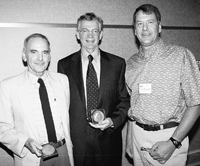
Craig A. Tracy (center) and Harold Widom (left) shared the 2002 George P�lya Prize "for their remarkable work on random matrix theory, a subject with multiple connections to complex analysis, orthogonal polynomials, probability theory, and integral systems." Tracy, a professor of mathematics at the University of California, Davis, and Widom, Professor Emeritus in Applied Sciences at the University of California, Santa Cruz, are shown here with SIAM president Tom Manteuffel in Philadelphia, at the SIAM 50th Anniversary Meeting. Tracy gave the prize lecture, "New Universal Limit Laws: Largest Eigenvalue Distributions of Random Matrices and Their Applications," at the meeting. Awarded every other year, the P�lya Prize commemorates the breadth of P�lya's mathematical interests by alternately recognizing notable applications of combinatorial theory and, as this year, notable contributions in other areas in which P�lya worked, such as approximation theory, complex analysis, number theory, orthogonal polynomials, probability theory, or mathematical discovery and learning.
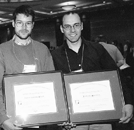
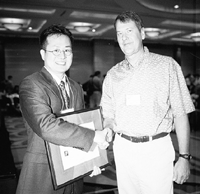
The SIAM Student Paper Prizes are given annually in recognition of students who have done outstanding work in applied mathematics or computing. The three recipients of this year's prizes are: (left,photo at top, above) Pierre-Antoine Absil (left) of the University of Li�ge, for "A Grassmann-Rayleigh Quotient Iteration for Computing Invariant Subspaces"; Andreas Waechter (right), now at the IBM T.J. Watson Research Center and a student at Carnegie Mellon University when he wrote his winning paper, "Global and Local Convergence of Line Search Filter Methods for Nonlinear Programming"; and (photo, above) Dong Eui Chang of the California Institute of Technology, for a paper titled "Controlled Lagrangian and Hamiltonian Systems."
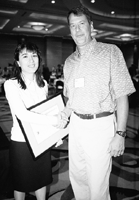
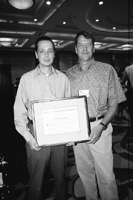
Three students received honorable mention: Atife Caglar (top) of the University of Pittsburgh, for "Weak Imposition of Boundary Conditions for the Navier-Stokes Equations by a Penalty-Lagrange Multiplier Method"; Philipp Kuegler (above) of Johannes Kepler University Linz, for "Identification of a Temperature Dependent Heat Conductivity from Single Boundary Measurements"; and John Dunagan (not pictured) of MIT, for "Optimal Outlier Removal in High-Dimensional Spaces."

The Mathematical Contest in Modeling, 18 years old and still growing, drew a record 525 three-member teams in 2002. As the SIAM winners, teams from the University of Washington and Duke University presented their solutions at a minisymposium during the SIAM 50th Anniversary Meeting. Shown above at the meeting with SIAM president Tom Manteuffel are (from left) James Case, a SIAM judge; David Arthur and Sam Malone of the Duke team (team member Oaz Nir is not pictured); MCM founder Ben Fusaro; and Ernie Esser, Ryan Card, and Jeff Giansiracusa of the University of Washington.
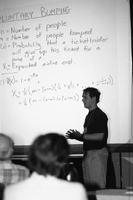
David Arthur described the Duke team's solution to this year's discrete problem, "Airline Overbooking," which asked contestants to devise a revenue-maximizing overbooking strategy for airlines, and to explain how such strategies need to be modified in the aftermath of September 11. The Washington team had solved the continuous problem, which involved the feedback control of an ornamental fountain. Contestants were asked to develop an algorithm that, by coordinating the height of the fountain with prevailing wind conditions, would produce the most attractive spectacle possible without spraying passers-by.
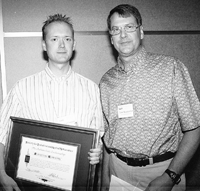
Jonathan Chapman of Oxford University, with SIAM president Tom Manteuffel, gave the first Julian Cole Lecture at the SIAM 50th Anniversary Meeting in Philadelphia. The Julian Cole Lectureship recognizes outstanding contributions to the mathematical characterization and solution of challenging problems in the physical or biological sciences, or in engineering, or for the development of new mathematical methods for such problems. Chapman, whose lecture was titled "Exponential Asymptotics and Linear and Nonlinear Eigenvalue Problems," was honored for his work in superconductivity; the prize committee cited his "outstanding contributions" to the mathematical theory, as well as his solutions to specific problems, "which will influence the emergence of this new technology," and his development of new mathematical methods. Funds for the Cole Lectureship were contributed by students, colleagues, friends, and family of Julian Cole, long-time SIAM member who died in 1999. The next Cole Lectureship will be awarded in 2006.
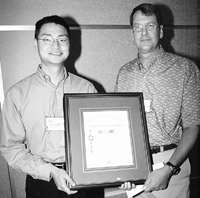
Gang Hu of the Fixed Income Research Department at Lehman Brothers received the 2002 Richard C. DiPrima Prize at SIAM's 50th Anniversary Meeting. Awarded annually to recognize outstanding research in applied mathematics done by people at the beginning of their careers, the prize honors the memory of Richard DiPrima, a SIAM president (1979-80) and member of the faculty at Rensselaer Polytechnic Institute.
Hu graduated from Tsinghua University in Beijing in 1995 and received a PhD from the California Institute of Technology, where his dissertation research was supervised by Thomas Hou. In his dissertation, "Singularity Formation in Three-Dimensional Vortex Sheets," the prize committee wrote, "he addresses a long-standing problem in applied mathematics, namely the characterization of singularities on a vortex sheet, and uses a combination of modeling, asymptotics, rigorous analysis, and numerical computation to obtain and validate his results."
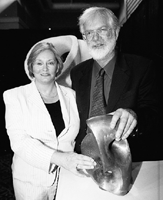
This year the Joint Policy Board for Mathematics (made up of representatives from the American Mathematical Society, the Mathematical Association of America, and SIAM) awarded its Communications Award to Claire and Helaman Ferguson. Together, the Fergusons excel at communicating mathematical ideas to general audiences. Helaman, whose sculptures have been featured several times in SIAM News (as has one of his algorithms), expresses mathematical concepts in bronze and stone. In her luminous essays, Claire gives viewers of the sculptures intriguing new ways to think about them. Those who stopped by the exhibit of Helaman's sculptures at SIAM's Philadelphia meeting had the chance to appreciate the talents of both.

